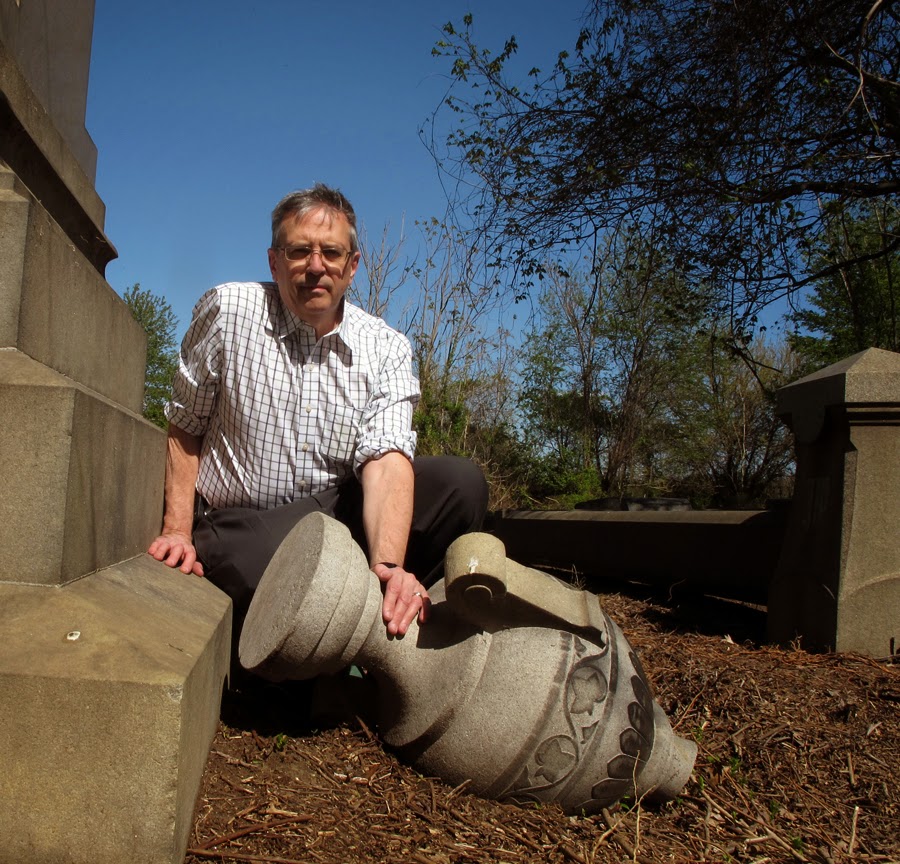No, that's not him above being killed by a falling headstone. That's a photo of me (taken by
my friend Karen Schlechter) in an abandoned cemetery lowering
a temporarily uprighted headstone. Some numbskull had raised it
(probably to read the face-down inscription) and propped it up with a
stick! I swear to you, this was right next to a playground in Norristown, PA. That stone must have weighed three hundred pounds. Horrific accident waiting to happen, don't you agree?
The title of this blog refers to an article on the WNEP-TV website that reads, “Man Killed by Falling Headstone While Decorating Family Grave … THROOP [near Scranton, in northeast Pennsylvania] — A man decorating a gravesite for Easter [2015] died Monday morning when a headstone fell on him in Lackawanna County.”
In reference to this accidental death, is it enough that the caretaker of the cemetery says (according
to the article) that “each spring when the ground begins to thaw, some of the
bases tilt and the stones on top can slip?” If you’re the owner of this (St.
Joseph’s in Throop or any other) cemetery, that’s a plausible excuse to give
the police. However, the next step should be taken – implementing a method of
securing the stones so this does not happen again. Ever. Anywhere.
Accidental cemetery deaths are not an unusual occurrence. A child recently died while playing in a churchyard cemetery in North Carolina. While attending Vacation Bible School, this WCYB.com story (click for link) states, “the children were running around when a massive cross fell off a tombstone and struck the girl.”
The title of this blog refers to an article on the WNEP-TV website that reads, “Man Killed by Falling Headstone While Decorating Family Grave … THROOP [near Scranton, in northeast Pennsylvania] — A man decorating a gravesite for Easter [2015] died Monday morning when a headstone fell on him in Lackawanna County.”
Getting past the irony of being
killed by a falling headstone, most people who have read this tragic account probably had one of
two reactions, either:“Oh my god
that’s horrible!” or “Tsk, what a
shame.” I would venture to guess that very few people read it and
think, “How can we prevent such tragedies in the future?
Accidental cemetery deaths are not an unusual occurrence. A child recently died while playing in a churchyard cemetery in North Carolina. While attending Vacation Bible School, this WCYB.com story (click for link) states, “the children were running around when a massive cross fell off a tombstone and struck the girl.”
A child died in Glenwood Cemetery in Park City, Utah in 2012, when a four-inch-thick, several hundred pound tombstone fell on him. According to Fox News, his father was taking pictures at the time (click for link).
 |
| My daughter |
There is a very subtle phrase in the recent Throop, PA story that I would like to clarify for you. When the caretaker says “some of the bases tilt and the stones on top can slip” what he means is this: When a headstone is installed, a stone base is placed in the ground and then the headstone is placed on this base. It has been done like this in the United States probably since the 1890s. You can see an example of such a n installation in this YouTube video, “How to Install a monument in a cemetery.” Also, if you look at my photo below of a vandalized grave marker, you can see that the headstone is typically not attached to the base.
 |
| Fallen headstone, unattached to base |
When I say to “pin” a headstones to it’s base, I refer to
the practice of setting steel rods into the base so that they protrude up and
can fit into holes in the bottom of the headstone. This secures the headstone
to the base (which is only a few inches wider that the footprint of the
headstone, by the way). This is not done all the time, though I have seen it
used for both marble and granite headstones (this is hardly ever done with
slate, as the stone is too brittle).
 |
| U.S. Government-issues grave markers |
 |
| Ed Snyder with fallen decorative granite urn |
 |
| Monument off which urn had fallen |
To summarize, this is a call to cemetery stone cutters –
please suggest to your customers that they pay the extra few dollars for pins
to be installed in their headstones and monuments! As for all those millions of unsecured and
off-level grave markers out there in our thousands of U.S. cemeteries,
I would suggest something on the order of what is happening currently in
Scotland. “Considering the delicate balance between safety and compassion, … every
council in Scotland is having to respond to the Health and Safety Executive
(HSE) which has asked them to conduct safety inspections of all cemeteries
within their jurisdiction, in the light of three fatal accidents of children
from falling memorials.” While a number of methods of insuring safety have been
implemented, probably the most dramatic is that of laying the stone down on the
ground, with its inscriptions facing up (read more at this link).
 |
| Memorial Park |
If all this sounds too complicated and expensive, safety
may be the only good reason for the “memorial park” cemetery design: with all
the grave markers being flush to the ground rectangular plates, there is
nothing to fall on people. The old Victorian "sculpture garden" cemeteries are wonderfully picturesque, however, do exercise caution when visiting.
________________________________________________________
Follow up story on the gentleman in northeast Pennsylvania who was killed on Easter by a falling headstone:



Great article on Headstones
ReplyDeleteExcellent informative
ReplyDelete